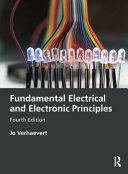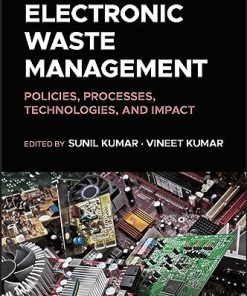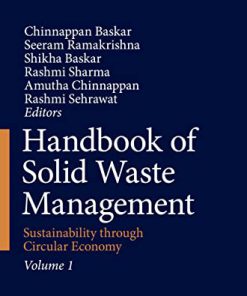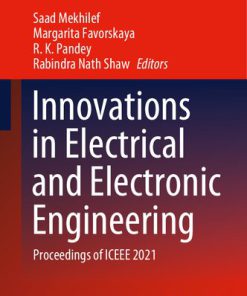Environmental Management of Waste Electrical and Electronic Equipment 1st Edition by Chaudhery Mustansar Hussain ISBN 9780128224892 0128224894
$50.00 Original price was: $50.00.$25.00Current price is: $25.00.
Environmental Management of Waste Electrical and Electronic Equipment 1st Edition by Chaudhery Mustansar Hussain – Ebook PDF Instant Download/Delivery: 9780128224892 ,0128224894
Full download Environmental Management of Waste Electrical and Electronic Equipment 1st Edition after payment

Product details:
ISBN 10: 0128224894
ISBN 13: 9780128224892
Author: Chaudhery Mustansar Hussain
Environmental Management of Waste Electrical and Electronic Equipment illustrates the socioeconomic, technical and environmental perspectives of WEEE, allowing for a better understanding on how to manage this rapidly growing waste stream. The book addresses discharge of WEEE into ecosystems, occupational exposure to hazardous components of WEEE, and loss of recoverable resources, bridging the gap between community and waste management. By providing in-depth analysis and step-by-step descriptions of environmental strategies and procedures for managing electrical and electronic waste, this book is a valuable resource for environmental scientists, environmental engineers, and waste management professionals to achieve sustainability in WEEE.
Presents the latest knowledge on the origin, identification and adverse effects of WEEE on humans and ecosystems
Offers up-to-date analysis on environmental management tools, such as LCA, health risk, legalization, and policies for sustainable solutions for Waste Electrical and Electronic Equipment (WEEE)
Includes details and analysis of the novel approaches proposed in recent years for resource recovery from WEEE
Environmental Management of Waste Electrical and Electronic Equipment 1st Edition Table of contents:
1 : Environmental problems and management aspects of waste electrical and electronic equipment and use of clean energy for sustainable development
Abstract
Keywords
1 Introduction
2 Sources of e-waste
3 Classification of e-waste
4 Challenges of e-wastes
4.1 Impact of hazardous substances on health and environment
5 Continent-wise and country-wise generation of e-wastes
6 Management aspects of e-wastes
6.1 E-waste generation and management in China
6.2 E-waste generation and management in the United States
6.3 E-waste generation and management in Japan
6.4 E-waste generation and management in India
7 Basel convention
7.1 Overview
7.2 Objective
7.3 Aims and provisions
8 Suggestions
9 Use of clean energy for sustainable development
10 Conclusion
References
2 : Waste electrical and electronic equipment and environment: context, implications, and trends
Abstract
Keywords
1 Introduction
2 Methodology
3 Results and discussion
3.1 Evolution in the general characteristics of WEEEE research
3.2 Evolution in WEEEE research by subject discipline
3.3 Most relevant journals in WEEEE research
3.4 Most relevant countries in WEEEE research
3.5 Most relevant institutions in WEEEE research
3.6 Most relevant authors in WEEEE research
3.7 Evolution of WEEEE research
4 Conclusions
Websites about topic
Other relevant contributions
References
3 : E-waste: an emerging threat to “one health”
Abstract
Keywords
1 Introduction
2 E-waste generation
2.1 Global context
2.2 Indian context
3 Impact on “One Health”
4 E-waste management and policy level initiatives in India
5 Conclusion
References
Further reading
4 : Microbe-assisted management and recovery of heavy metals from electronic wastes
Abstract
Keywords
1 Introduction
2 Composition of WEEE
3 Environment concerns and health hazards
4 Burgeoning burden of e-waste
5 WEEE management strategies
5.1 Landfilling
5.2 Incineration
5.3 Transboundary shipment
5.4 Recycling
5.5 Reuse
6 Metallurgical processing of WEEE
6.1 Pyrometallurgical processes
6.2 Hydrometallurgical methods
6.3 Electrometallurgical processes
6.4 Biometallurgical processes
7 Conclusion
References
Websites
5 : Biohydrometallurgical methods and the processes involved in the bioleaching of WEEE
Abstract
Keywords
1 Biological management of e-waste
2 Biohydrometallurgy for e-waste treatment
3 Modes of biohydrometallurgy
3.1 Contact mechanism
3.2 Noncontact mechanism
4 Processes involved in biohydrometallurgy
4.1 Bioleaching
4.2 Biooxidation-reduction
4.3 Biosorption
4.4 Bioaccumulation
4.5 Bioprecipitation
5 Bioleaching methods
5.1 One-step bioleaching
5.2 Two-step bioleaching
5.3 Spent medium bioleaching
6 Sequential batch bioleaching
7 Conclusion
References
6 : Hybrid bioleaching—an emerging technique for extraction of critical metals from WEEE
Abstract
Keywords
1 Introduction
2 Occurrence of critical metals in PCBs
3 Overview of hybrid bioleaching process
4 Applicability of hybrid bioleaching for extraction of critical metals from WEEE
5 SWOT analysis
6 Future perspectives
7 Conclusions
References
7 : Current trends and future perspectives of biobased methods for recovery of metals from WEEE for a sustainable environment
Abstract
Keywords
1 Introduction
1.1 Toxicants
2 Modeling and simulation studies regarding chemical and physical methods
2.1 Recycling of e-waste by chemical methods
2.1.1 Recycling of e-waste by pyrolysis
2.1.2 Recycling of e-waste by hydrometallurgical method
2.2 Recycling of e-waste by physical methods
3 Alternative technology to recycle metals from e-waste
3.1 Cyanogenic bacteria for gold recovery
3.1.1 Chromobacterium violaceum
3.1.2 Genus pseudomonas
3.1.2.1 P. fluorescens
3.2 Bioleaching process on lithium-ion batteries
4 Current trends and future prospectus
References
Websites
8 : Recycling of e-waste in concrete
Abstract
Keywords
Acknowledgments
1 An introduction to concrete
2 Environmental impacts of concrete
3 Importance of e-waste management
4 E-waste in concrete
4.1 Cathode ray tubes recycling in concrete
4.2 LCD recycling in concrete
4.3 Plastic recycling in concrete
4.4 Printed circuit board recycling in concrete
4.5 Wire recycling in concrete
5 Conclusions
References
9 : Biological treatment, recovery, and recycling of metals from waste printed circuit boards
Abstract
Keywords
1 Introduction
2 Classification, toxicity, and impact of WPCBs
2.1 WEEE metal composition
2.2 Toxicity
2.3 Environmental impacts
3 Bio-based technologies for recovering metallic resources from waste PCBs
3.1 Mechanisms of bioleaching
3.1.1 Acidolysis
3.1.2 Redoxolysis
3.1.3 Complexolysis
3.2 Microbes for bioleaching
3.2.1 Autotrophic microbial bioleaching
3.2.2 Heterotrophic microbial bioleaching
3.2.3 Fungal bioleaching
3.3 Bioleaching of base metals
3.4 Factors affecting the bioleaching of base metals
3.5 Bioleaching of precious metals
4 Effect of process factors for the bioleaching of precious metals
5 Future perspective and challenges
6 Conclusions
References
10 : Process engineering for bioleaching of metals from waste electrical and electronic equipment
Abstract
Keywords
1 Introduction
2 Principles of metal bioleaching
3 Microbiology involved in metal bioleaching
4 Application of bioprocess engineering for metal bioleaching from WEEE
5 Modes of bioreactor operation for metal bioleaching from WEEE
5.1 Batch operation
5.2 Fed-batch operation
5.3 Continuous operation
6 Bioreactor design for bioleaching of metals from WEEE
6.1 Column bioreactor
6.2 Stirred tank bioreactor
6.3 Packed-bed bioreactor
6.4 Other bioreactor configurations
7 Limitations of bioprocessing of WEEE
8 Conclusions and future perspectives
References
11 : Financial stimulation policy as a part of socioeconomic intervention in the area of waste electrical and electronic equipment recycling
Abstract
Keywords
1 Introduction
2 Socioeconomic and legislative ambience in the area of WEEE recycling
3 Socioeconomic benefits in waste electrical and electronic equipment recycling
4 Socioeconomic intervention in the area of waste electrical and electronic equipment in the Republic of Serbia
5 Conclusion
References
Further reading
12 : Achievement of sustainability by tackling e-waste overpower
Abstract
Keywords
Acknowledgments
1 Introduction
2 Sources of e-waste
3 Impacts of WEEE
4 Impacts on atmosphere
5 Impacts on soil
6 Impacts on ecosystem
7 Impact on human beings
8 Legal framework for waste management
9 Existing EU laws
10 UN e-waste coalition
11 The e-waste management and handling rules, 2011
12 E-waste management rules, 2016
13 Amendment to the E-Waste Management Rules, 2018
14 WEEE management strategies
15 Case study Switzerland
16 Conclusion
References
Further reading
13 : Advances in global research on the sustainable management of waste electrical and electronic equipment
Abstract
Keywords
Acknowledgments
1 Introduction
2 Methodology
3 Results and discussion
3.1 Evolution in the general characteristics of SMWEEE research
3.2 Evolution in SMWEEE research by subject discipline
3.3 Most relevant journals in SMWEEE research
3.4 Most relevant countries in SMWEEE research
3.5 Most relevant institutions in SMWEEE research
3.6 Most relevant authors in SMWEEE research
3.7 Sustainability aspects
4 Conclusions
References
Websites about topic
Other relevant contributions
People also search for Environmental Management of Waste Electrical and Electronic Equipment 1st Edition:
examples of environmental management plans
examples of waste management systems
examples of environmental waste
environmental management of waste
environmental management system in evs
Tags: Chaudhery Mustansar Hussain, Environmental Management, Waste Electrical
You may also like…
Engineering - Environmental
Computers - Computer Science
Business & Economics - Others
Chemistry - Technical & Industrial Chemistry
Engineering - Electrical & Electronic Engineering
Earth Sciences - The Environment
Uncategorized
Engineering - Environmental
Handbook of Solid Waste Management 1st Edition by Chinnappan Baskar 981164229X 9789811642296
Computers - Computer Science











